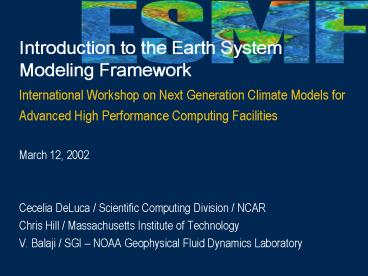Introduction to the Earth System Modeling Framework PowerPoint PPT Presentation
1 / 15
Title: Introduction to the Earth System Modeling Framework
1
Introduction to the Earth System Modeling
Framework
- International Workshop on Next Generation Climate
Models for - Advanced High Performance Computing Facilities
- March 12, 2002
- Cecelia DeLuca / Scientific Computing Division /
NCAR - Chris Hill / Massachusetts Institute of
Technology - V. Balaji / SGI NOAA Geophysical Fluid Dynamics
Laboratory
2
Outline
- Background and Motivation
- ESMF Design Overview
- ESMF Codes
- Milestones
- Development Plan
- Beyond 2004 ESMF Evolution
- Additional Information and Events
3
Trends in Earth System Modeling
- In climate research and numerical weather
prediction - Increased emphasis on detailed representation of
individual physical processes - Requires many teams of specialists to contribute
components to a coupled system - In computing technology
- Increase in complexity and variety in
high-performance computing hardware - Community Response
- Abstraction of underlying hardware to provide
uniform programming model across architectures - Modular design for interchangeable dynamical
cores and larger components - Development of prototype frameworks - GFDL (FMS),
NASA/GSFC (GEMS), others - The Earth System Modeling Framework (ESMF) aims
to unify and extend these efforts
4
Project Background
NASAs Earth Science Technology Office (ESTO)
proposed the creation of the ESMF in a September
2000 Cooperative Agreement Notice Large
collaboration developed three linked proposals
in responsePart I Core ESMF Development (PI
Killeen, NCAR)Part II Modeling Applications
(PI Marshall, MIT)Part III Data Assimilation
Applications (PI da Silva, NASA DAO)
5
Project Organization
NASA ESTO
Part I
Part II
Part III
Data Assimilation Deployment
Core Framework Development
Prognostic Model Deployment
NSF NCAR PI
MIT PI
NASA DAO PI
Part I Proposal Specific Milestones
Part II Proposal Specific Milestones
Part III Proposal Specific Milestones
Joint Milestones
Joint Milestones
Joint Milestones
Joint Specification Team Requirements
Analysis System Architecture API Specification
6
Objectives of the ESMF
- Facilitate the exchange of scientific codes
(interoperability) - Promote the reuse of standardized technical
software while preserving computational
efficiency - Focus community resources to preserve performance
portability in a volatile computing environment - Share overhead costs of the housekeeping aspects
of software development - Provide greater institutional continuity to model
development efforts
7
Framework Architecture
8
Application Architecture
Coupling Layer
ESMF Superstructure
Model Layer
User Code
Fields and Grids Layer
ESMF Infrastructure
Low Level Utilities
External Libraries
BLAS, MPI, NetCDF,
9
ESMF CodesModeling Applications
10
ESMF CodesData Assimilation Applications
11
Final Milestones
- Tested, optimized core framework software and
documentation - Support for many platforms, including commodity
clusters - All ESMF codes will achieve full ESMF compliance
- Will use coupling superstructure and utilities
- 8 Interoperability demonstrations
- Example NCAR CAM with MITgcm ocean
- Multiple time scales
- NWP, mid-range forecast experiments
- Coupled seasonal forecasts
- Interannual/decadal variability
- Centennial simulations
- Will require tuning and validation to be
scientifically useful
12
Development Plan
- Requirements
- Intensive interaction involving ESMF
collaborators and broader community, ESMF
Community Requirements Meeting - High-level results presented in General
Requirements Document, detailed requirements
documents prepared later - Design
- Design study includes examination of FMS, GEMS,
MCT, and other existing Earth science frameworks - Results presented in Architecture Report,
detailed design documents for specific components
prepared later - Community review of ESMF interface specification
13
Development Plan, cont.
- Implementation
- Implementation study will determine
implementation language, language
interoperability strategy, programming model - Examine viability of supporting software tools,
e.g. CCA, Cactus - Results presented in Implementation Report
- Best Practices
- Early distribution of Software Developers Guide
will encourage consistent standards, conventions
and practices throughout the project
14
Beyond 2004ESMF Evolution
- Maintenance and management
- NCAR commitment to maintain and support core ESMF
software - Persistence of ESMF Executive Committee and
Advisory Board - Technical evolution
- Functional extension support for advanced data
assimilation algorithms, additional grids, new
domains - Earth System Modeling Environment, including
web/GUI interface, databases of components and
experiments, links to GRID services
15
Additional Information and Upcoming Events
- ESMF Community Requirements Discussion and Review
- Open Meeting
- In conjunction with the Spring
- American Geophysical Union Meeting
- May 30, 2002
- ESMF website http//www.esmf.ucar.edu
- Questions esmf_at_ucar.edu

